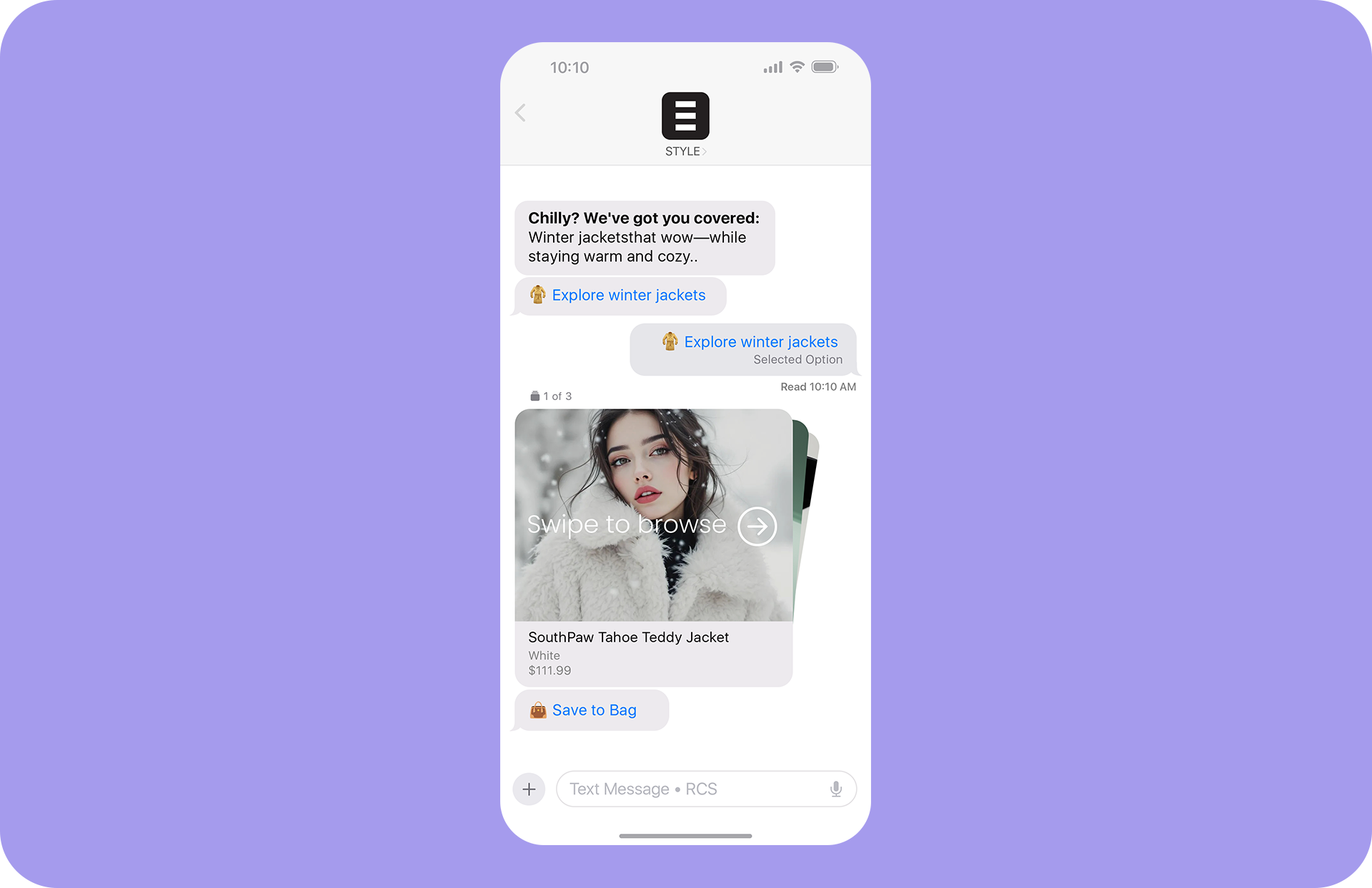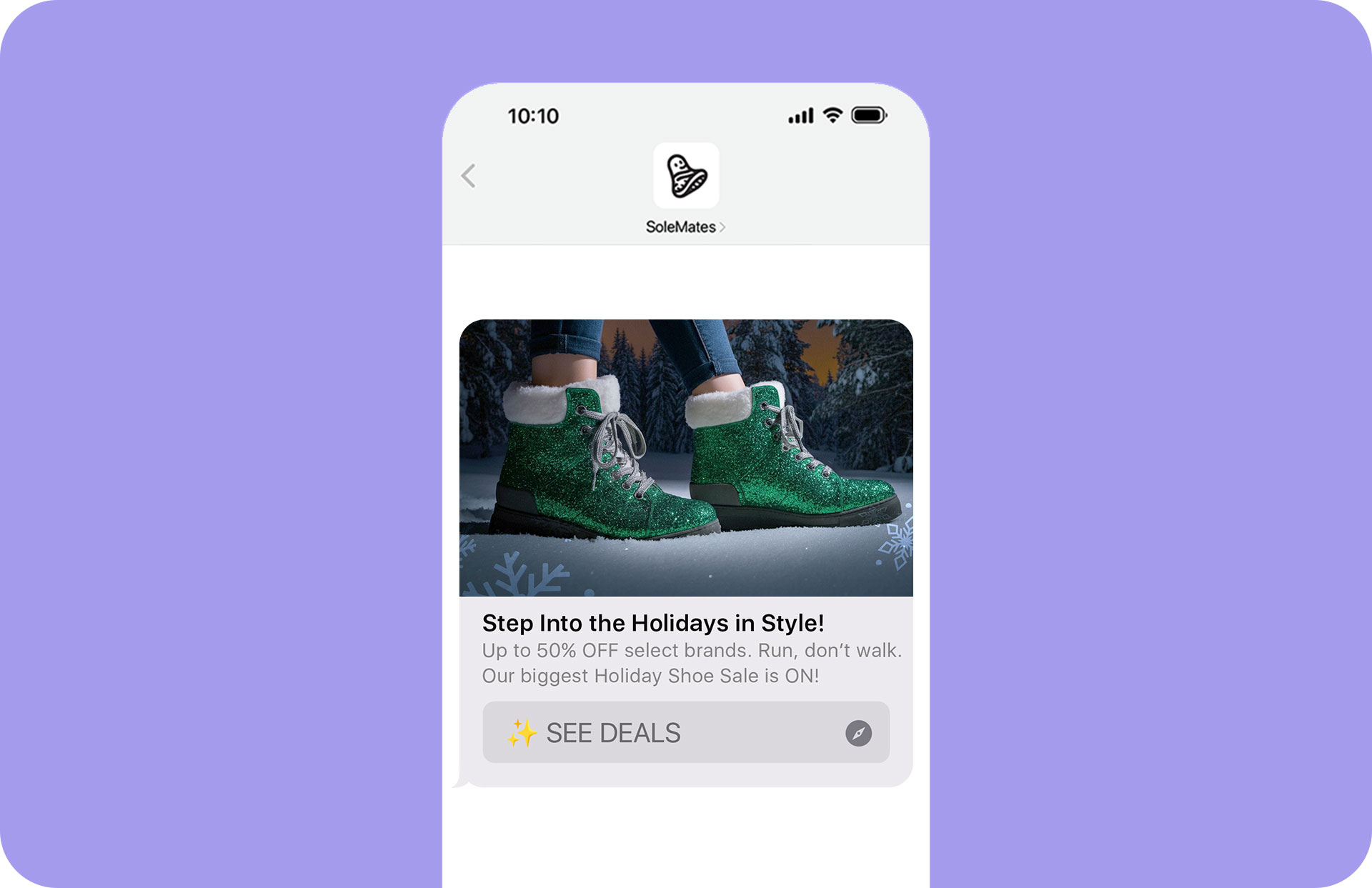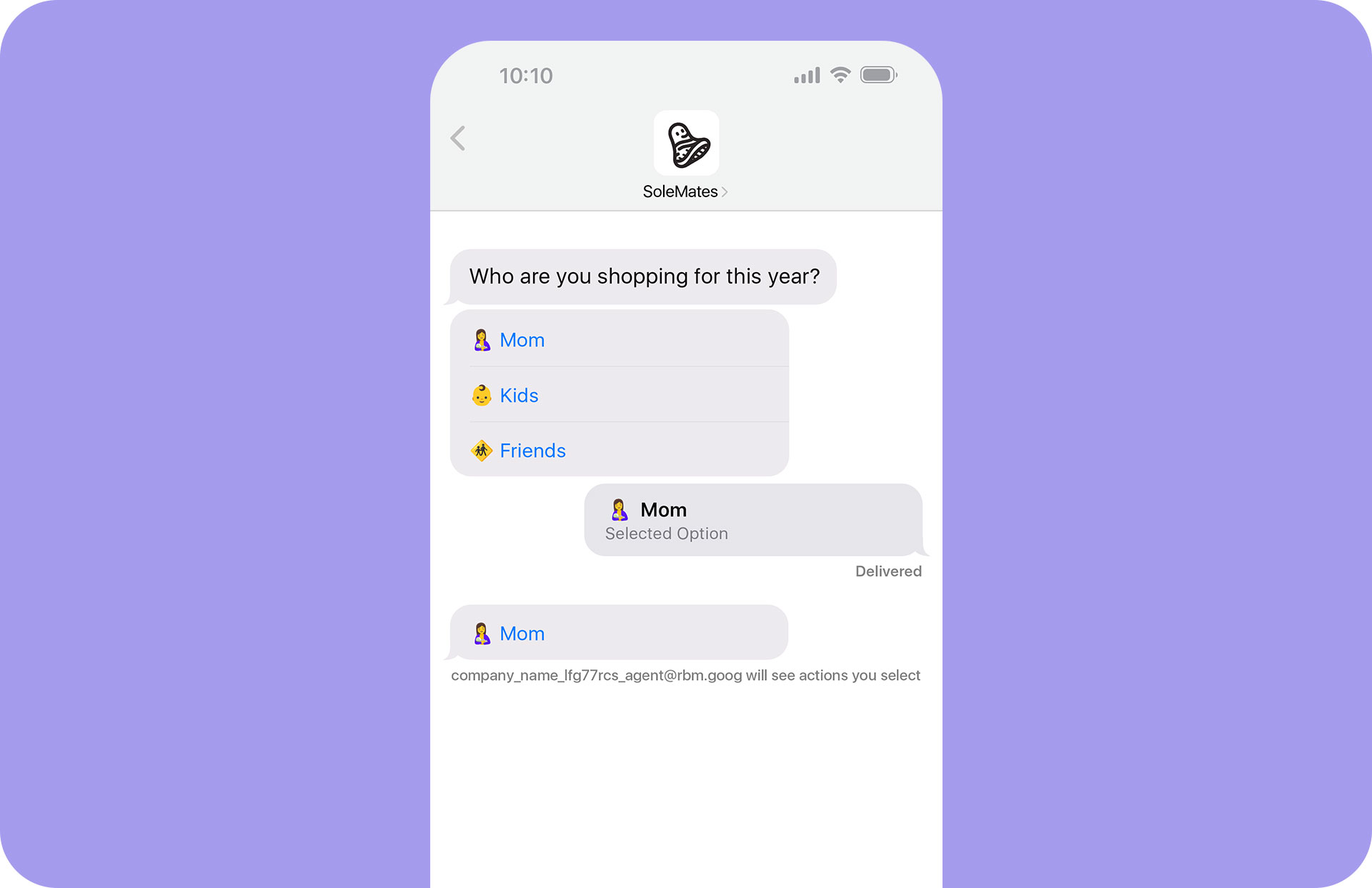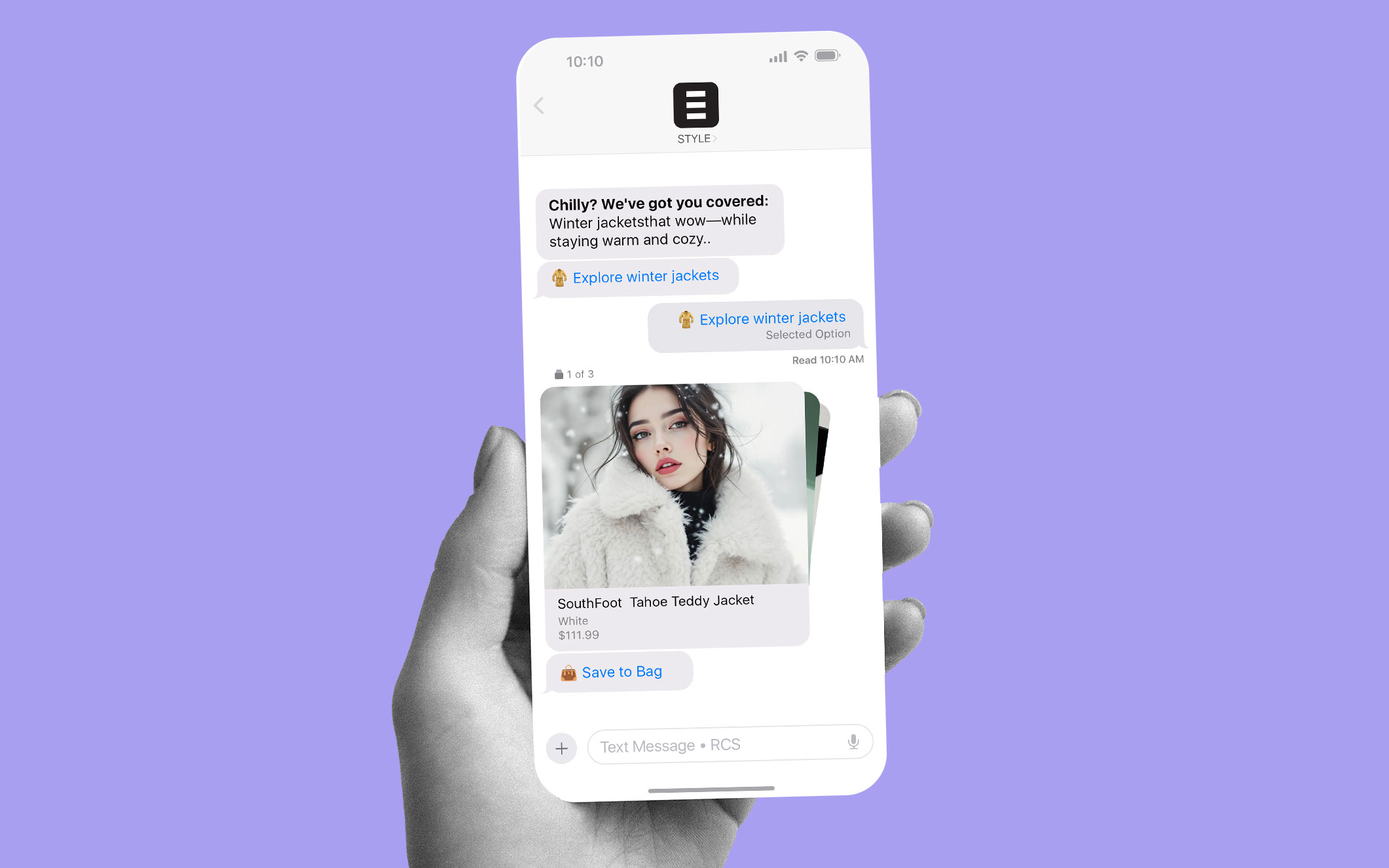
Every holiday season brings a flood of promotions, but 2025 will mark a turning point.
For the first time in North America, RCS is now a potential part of a brand’s mobile marketing mix. It gives retailers a way to deliver branded, interactive experiences right inside the messaging inbox. Holiday RCS campaigns from names like Crate & Barrel are already hitting phones — and consumers are beginning to expect this richer, app-like experience.
At Vibes, we’ve been at the forefront of this shift. We’re leading the launch of RCS in North America with brands like The Children’s Place and many others — and learning alongside them what resonates and what doesn’t.
That’s why this holiday season feels different. RCS is both a huge opportunity and a real risk. Done well, it cuts through the holiday noise with engaging experiences that drive loyalty. Done poorly, it confuses consumers with unfamiliar flows and unclear calls-to-action — often leading to fewer clicks than the SMS and MMS messages you’re used to sending.
So how do you get it right? Here are a few tips to help retailers make RCS shine in their holiday campaigns.
The first rule of holiday RCS is simple: Don’t overcomplicate it.
Many consumers are still learning what RCS is, and the experience isn’t second nature yet. While RCS has the potential to transform how brands interact with customers on mobile, that shift won’t happen overnight. If you jump straight into elaborate journeys, you risk building something impressive that falls flat simply because people don’t know how to engage with it.
That doesn’t mean RCS doesn’t still have tremendous value over SMS. It means you need to start simple and evolve over time. For a first RCS campaign, keep it familiar: eye-catching imagery with clear text and a single link (not a button), the way customers already expect. Once they’re comfortable, you can gradually introduce richer features — buttons, carousels, and conversational flows — layering in deeper interaction without sacrificing clarity.

Use carousels with purpose.
Carousels are one of the most eye-catching features of RCS, but they’re also one of the easiest to misuse. We’ve seen brands drop five nearly identical cards into a carousel, all pointing to the same link. The result? Confusion, fatigue, and little value added over a basic message.
The real strength of carousels lies in their ability to mimic the browsing experience right inside the messaging app. Think of it as a curated holiday aisle: showcase different gifts under $50, best sellers or exclusive bundles. Each card should have its own reason for being there, with distinct visuals and unique links. Separate links don’t just make for a better shopping experience — they give you sharper analytics. You’ll see exactly which products get love and which ones get ignored, and that’s gold for your next campaign.
And remember, many consumers haven’t seen carousels before — so you need to be explicit in showing them how to use them. Always include a clear cue like “Swipe” so customers learn how to engage with the format.

Make your buttons pop.
Buttons are a powerful feature in RCS messages, but another one that consumers aren’t fully familiar with. A plain ‘Shop Now’ button can disappear into the background. But add a 🎁 or ✨ and suddenly your CTA jumps off the screen. You can also incorporate capitalization (“SHOP NOW”) or action-oriented phrasing (“SEE DEALS”) to help buttons pop.
The key is balance. Too many emojis or overly clever language can confuse customers, especially since RCS and tappable buttons are still new — so make sure every button is instantly understandable.
When done right, styled buttons do more than look festive. They make your CTAs easier to find, easier to act on, and more engaging than SMS could ever allow.

Turn RCS into a data collection engine.
One of the most powerful features of RCS — and one that truly separates it from SMS — is its ability to run two-way, conversational flows inside the messaging thread. Instead of sending shoppers to a landing page or form, you can ask them questions and capture their answers in real time, without any drop-off.
Used thoughtfully, this turns a holiday promotion into both a sales driver and a data engine. Imagine sending an early-season message that asks: “Who are you shopping for this year?” with options like Mom, Kids, or Friends. With one tap, the customer not only gets a tailored set of recommendations, but you’ve also captured intent data you can use to shape the rest of your campaigns.
The caution here is timing. Don’t overload consumers with a survey in their first RCS message. Start with a simple, rewarding interaction and build from there. Over time, you’ll train your audience to expect that your RCS messages don’t just broadcast offers; they start a conversation. And in doing so, you’re gathering the kind of first-party data that becomes invaluable long after the holiday rush.

Use the holiday rush to learn fast.
No other moment in the retail calendar delivers the same combination of volume and urgency as the holiday season. That makes it the perfect environment to learn quickly. Every RCS campaign you send — whether it’s a simple text + link, a carousel, or a conversational flow — generates data you can act on in real time.
This is where RCS analytics shine. Unlike SMS, which only gives you limited click data, RCS shows you exactly which buttons were tapped, which carousel cards were swiped, and where customers dropped off in a flow. Those insights let you pivot mid-season: doubling down on the content and offers that resonate, pulling back on what doesn’t, and fine-tuning your timing and tone.
Treat each campaign like a mini experiment. One message might flop — and that’s okay — because the next one will be sharper thanks to what you learned. And when the season ends, you’ll walk away with a richer playbook — not just for next December, but for every promotion you run in 2026.
Closing thoughts
The holidays are the ultimate proving ground for mobile marketing, and this year RCS is front and center. For retailers, the opportunity is massive: richer experiences, deeper engagement, and better data than SMS has ever offered. However, consumers are still learning what RCS is, which means the brands that win will be those that introduce it thoughtfully.
At Vibes, we’re proud to be helping some of North America’s largest retailers lead the way in launching RCS messaging. By pairing our carrier, Google, and Apple partnerships with hands-on experience running campaigns at scale, we know what works and what doesn’t. Our advice for this season is simple: start with clarity, add creativity where it makes sense, use the conversational power of RCS to both sell and learn, and let analytics guide you forward.
Interested in learning more about how RCS can shape your holiday mobile marketing plan? Watch our free webinar.






